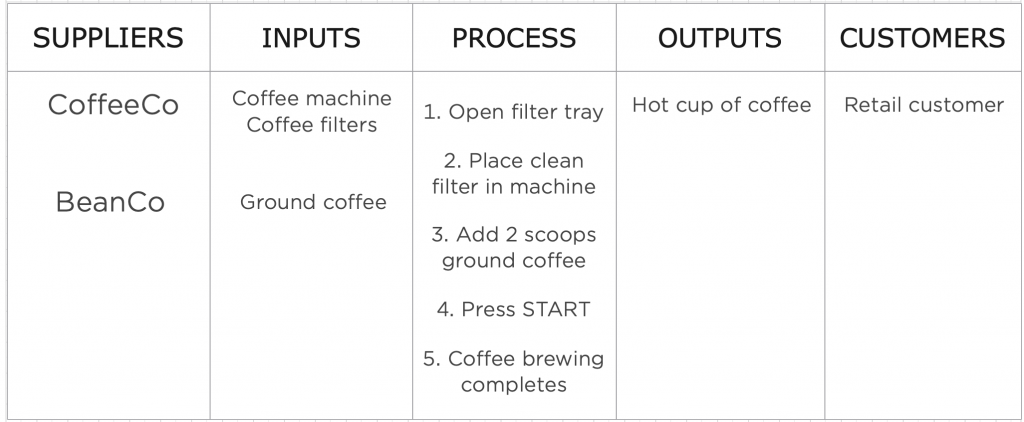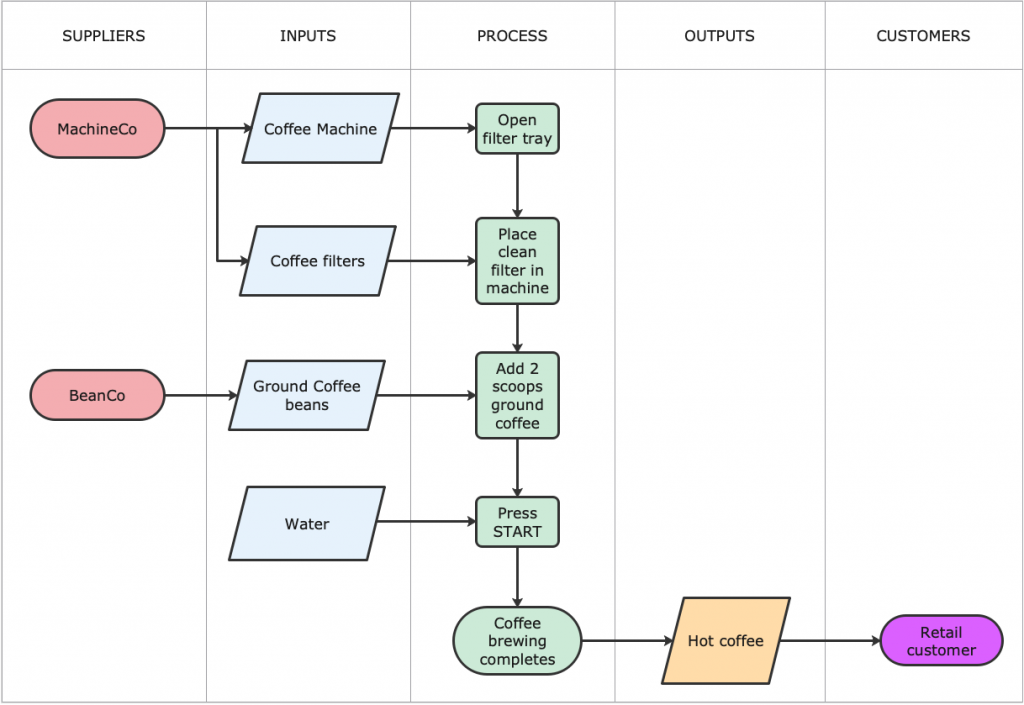SIPOC stands for “Suppliers, Inputs, Process, Outputs, and Customers.” If you want to get to know your processes a bit better, or facilitate a session with your stakeholders to get to know their processes better, a SIPOC diagram may just be the right solution for you.
Why is it useful?
A SIPOC diagram is a valuable and very easy-to-use brainstorming tool. It allows you to easily identify what pieces go into a process, where those pieces comes from, what steps the process takes, what comes out of the process, and who it’s for! All that in one simple diagram that’s really easy to get started using with no practice and no experience at all.
What is a SIPOC diagram?
A SIPOC diagram can be a chart or an actual diagram. It provides you with a structure to guide you through the identification of items, people, vendors, and steps that are necessary to create the product or service that you are producing. If your company or department produces an “output” (the product, service, or information as a result of the process), this handy tool helps you to identify all the things that go into producing that output.

The SIPOC diagram is commonly-used in the manufacturing industry, however, its use has expanded over the years to become quite beneficial for service and information-based companies/activities as well.
Does your department or company deliver a service, like IT, marketing, or sales? Does your department or company transform or produce information, like surveys, statistics, or reports? SIPOC diagrams are now also useful for supporting process understanding in those areas as well.
How do I use a SIPOC diagram?

Maybe the best way to show you how to use it is to begin with a couple visual examples. Let’s say our department or company produces cups of coffee to sell. Here are a couple of very simplified SIPOC diagrams to outline the main activity of producing a cup of coffee.
Example 1: using text only

Example 2: using visual objects

The approach can be very flexible and you can choose to add more or less details and use objects, icons, and colors to make it more appealing. It’s up to you how you would like to present the information but the point is that this approach guides you through identifying key things in your process such as:
- Suppliers (people, vendors, partners, other departments or systems)
- Inputs (materials, sources of information or outputs from services, systems or other processes)
- Process (the steps that are taken to transform the inputs to outputs)
- Outputs (the end result of taking inputs and running them through your process)
- Customers (people, customers, other departments)
If you need more details in your SIPOC (e.g., time/duration, specifications, interfaces/integrations, contact info, etc.), you can add more to some extent. I would say that if you need to add a bit of detailed info, go for it! But stop when the chart/diagram is beginning to get too cluttered. If you find that’s the case, it may be an indicator that you need to use another process improvement tool or two, such as process workflow/mapping diagrams and value stream mapping.

In summary…
The beauty of a SIPOC diagram is that there isn’t a whole lot of explaining to do around its use and it can be an effective tool for an individual user or with a team. It’s really easy to “wing it” if you’ve never used one before and how you document and interact with it is extremely flexible.
You can use a Word or Excel document with ease. Prefer a whiteboard approach? Go for it! Prefer stick-it notes on a wall? You can do that too!
Oh, no! You’re at a coffee shop with no laptop or whiteboard? Thank goodness for pen and paper napkins.
Now, get to it. Make it your day’s goal to create one SIPOC diagram and have fun doing it!

Process Primer Consulting is here if you need more advanced and experienced process improvement support. Feel free to schedule a free consult and we’ll be happy to have coffee with you and discuss improvement opportunities catered to your business goals.
Have questions? Need more information?
Leave a comment or contact us and we’ll be happy to respond!
Be healthy, be safe and be efficient.
Alwin Kwan
Your Friendly Neighbourhood Process Consultant
Comprehend. Reimagine. Outperform.
1 Comment